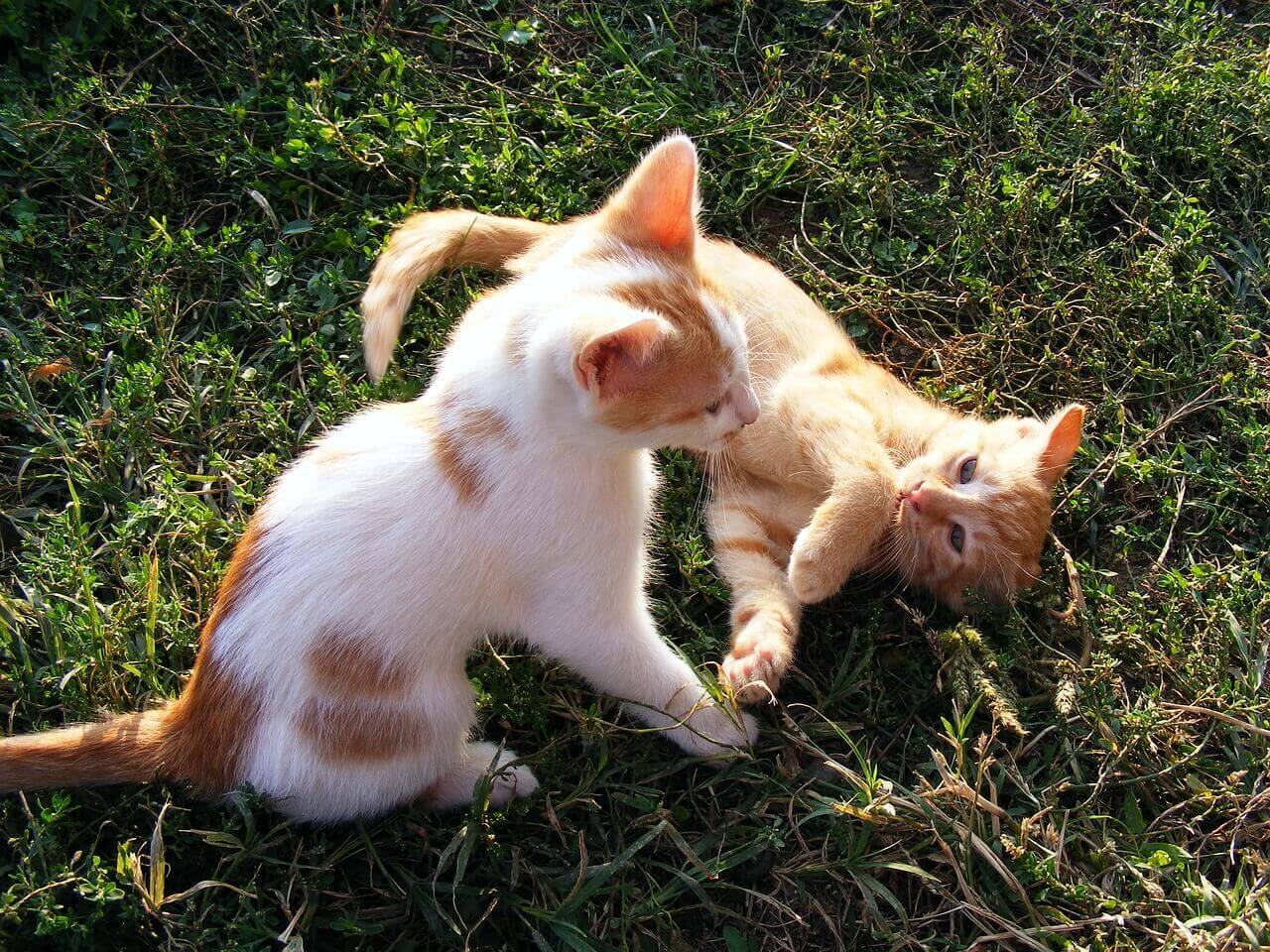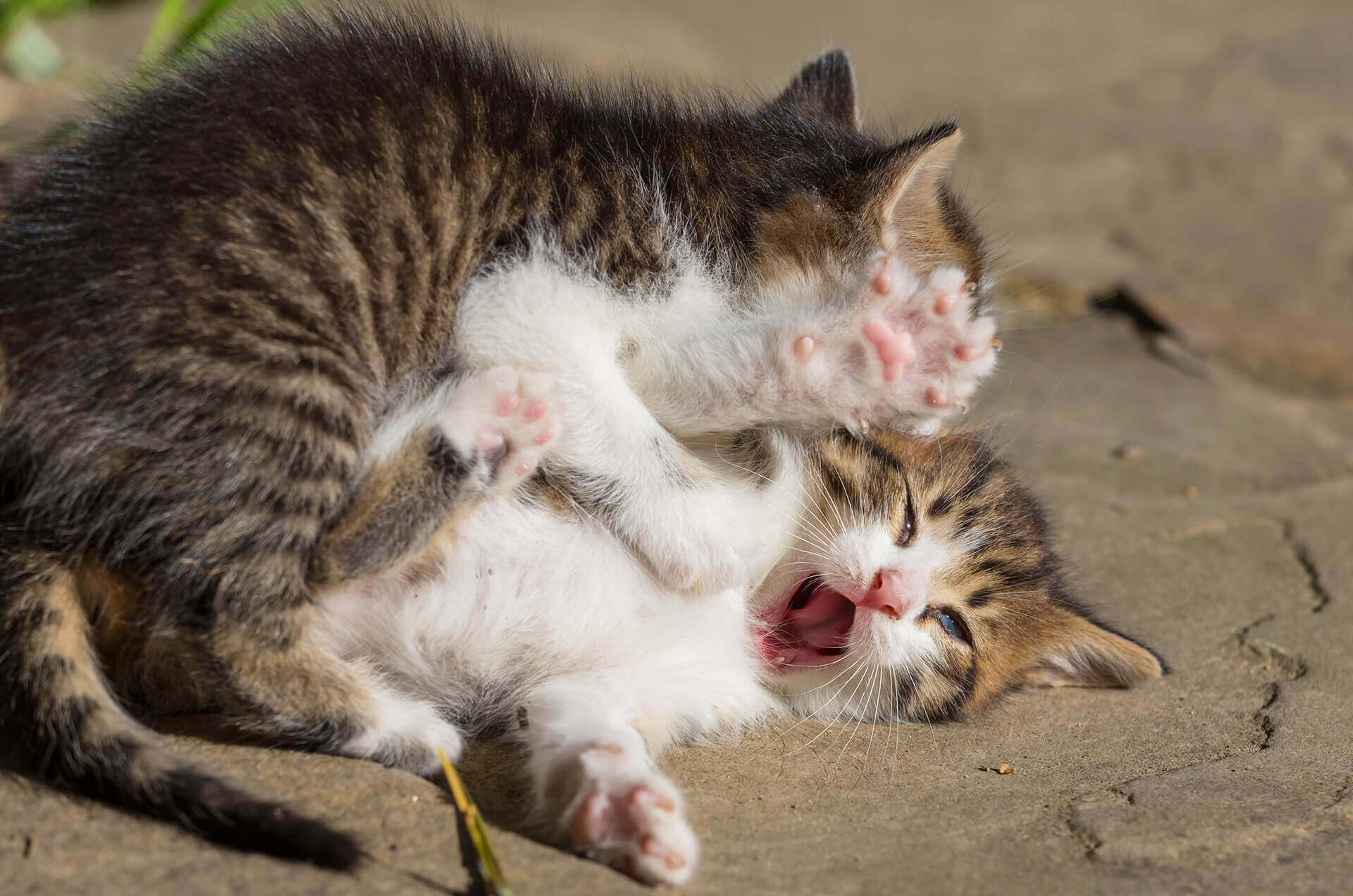Are My Cats Playing or Fighting?

Non-human animal play often involves claws and teeth. Although this doesn’t necessarily pose a danger for the animals involved, it does cause confusion for many of their guardians, who often don’t know whether their cats are playing or fighting. Fortunately, knowing how to tell the difference becomes easier if you know where to look.
Therefore, in this space, you’ll find tips for interpreting the body language of domestic felines so that you’ll be able to tell the difference between a game between cats and a real fight. Don’t miss a single detail because it’s essential to know how the animals that live with you relate to one another.
What can I do to distinguish whether my cats are playing or fighting?
As we mentioned above, in order to know if two cats are having a friendly relationship or are in the middle of a fight, you need to pay attention to their body language. Some signs are more subtle than others, so pay attention to the explanations below.
Friendly behaviors: Bonding play

First, let’s describe play between cats. When feeling playful, domestic felines may display behaviors that appear aggressive, such as dilating their pupils, wagging their tails as if agitated, or stalking to pounce on feet or hands. However, in these cases, there’s no agonistic intent whatsoever.
The key to distinguishing this is that all of these behaviors are much quieter and inefficient than those seen in an aggressive situation. That is, the bites aren’t going to cause injury; you won’t hear snorting or tearing meows, nor will you see bristling of the fur on the back or tail.
In addition, the cat might adopt compromising positions, such as showing its belly, which you would never observe in situations of real danger.
Therefore, you’re observing behaviors of environmental control and provocation, but these aren’t defensive or aggressive. Cats tend to imitate each other’s behaviors, and it would be very rare for injuries to appear after this type of interaction. Let’s see what we can observe when two cats are fighting.
Combative behaviors in cats: True fighting
When two cats prepare for a fight, the first thing they’re likely to do is to try to avoid it through intimidation (as opposed to play, where they invite the other to participate). In this case, specific details of aggression and threat are observed:
- Prolonged and loud meowing, with a hoarse tinge rising to a high-pitched squeal
- Bristling back and tail fur
- Snorting, the exposure of fangs
- Arching of the back
- Intimidating approaches, without actually fighting, to get the other to move away
If a fight breaks out, the aggression will be much more extreme and aimed at causing real damage. In this case, you’ll see injuries after the fight.
How to stop a fight between cats

After learning to differentiate whether two cats are playing or fighting, you’re likely to ask what you can do to stop a fight between cats. The first instinct that comes is, obviously, to get in the middle to separate them.
However, this isn’t the most advisable thing to do because you can escalate the aggression and get a good wound as a souvenir. So, what should you do? The best thing to do is to scare the cat by banging on a table, clapping hard, banging two pots or pans together, etc.
Once you’ve managed to separate them, be sure to isolate them in separate rooms. Until you see the signs of stress and anxiety disappear, it’s important not to allow them to interact again. And, after the fight, you should follow the steps of an initial introduction (as if it were meeting for the first time), and do so as progressively as possible.
Wouldn’t scaring them in order to separate them be a bad idea?
Although causing stress to your animal isn’t something you should do to condition it, in these cases, it’s better to separate them this way and then treat them separately to see if they have any injuries. In any case, when two cats fight, it’s because there has been a series of previous frictions that have led them to that point, so it’s always better to be safe than sorry.
How to prevent fights between your cats
Each animal has its own personality and acts, in part, by following its instincts. In the case of cats, their wild ancestry coexists with the long process of domestication to which they’ve been subjected, so it’s best to treat each situation individually.
The first step, as you can imagine, is to know your cats thoroughly and be able to recognize when they’re playing or fighting.
At the first sign that there might be tension between them, your task will be to improve the conditions of their coexistence. Here are some things you can do:
- Before introducing a second cat into your home, make sure you know all the steps for a successful introduction.
- Never force them to interact, but reinforce positive approaches.
- Provide separate spaces for resting, feeding, and going to the bathroom: It’s very important that you have several beds, litters, and bowls for them to choose from. Some felines need more privacy than others.
- Provide environmental enrichment: That is, add elements that, as the word says, enrich the animal’s life, such as scratching posts, intelligence games, or social interaction with humans. An article published in the journal Applied Animal Behaviour Science states that stimulating a cat’s mind and helping it to practice natural behaviors reduces stress.
- Consider using feline hormones: In some cases, this helps reduce stress and anxiety in cats, which will help you promote positive interactions between them.
- Maintain a calm and peaceful environment at home, as your pets are also affected by this.
- Never adopt a cat before it’s been weaned: We know that, in addition to health problems, this implies an increase in aggressive behaviors and stereotypies. If, for example, your cat is an orphan or a rescue cat, keep in mind that you’ll have to place special emphasis on educating it during its socialization stage.
The importance of professional advice
Taking care of several animals at home is a big responsibility. Therefore, and as a last piece of advice, consider enlisting the help of a feline ethologist, as not all guardians have all the theoretical and practical resources at their disposal.
Above all, remember that this responsibility doesn’t have to be a burden; giving your cats proper care can be the best experience of your life.
All cited sources were thoroughly reviewed by our team to ensure their quality, reliability, currency, and validity. The bibliography of this article was considered reliable and of academic or scientific accuracy.
- Ahola, M. K., Vapalahti, K., & Lohi, H. (2017). Early weaning increases aggression and stereotypic behaviour in cats. Scientific Reports, 7(1), 10412. https://www.nature.com/articles/s41598-017-11173-5
- Albright, J. D., Calder, C., & Learn, A. (2022). Introduction to Cat Behavior. Animal Behavior for Shelter Veterinarians and Staff, 30-52. https://onlinelibrary.wiley.com/doi/abs/10.1002/9781119618515.ch2
- Best Friends Animal Society. (s. f.). Cat Body Language: Communication and Expression. Consultado el 8 de junio de 2023. https://resources.bestfriends.org/article/cat-body-language-communication-and-expression
- Best Friends Animal Society. (s. f.). Cat Aggression Toward Other Cats: Steps for Changing Aggressive Feline Behavior. Consultado el 8 de junio de 2023. https://resources.bestfriends.org/article/cat-aggression-toward-other-cats-steps-changing-aggressive-feline-behavior
- Foreman-Worsley, R., & Farnworth, M. J. (2019). A systematic review of social and environmental factors and their implications for indoor cat welfare. Applied Animal Behaviour Science, 220, 104841. https://www.sciencedirect.com/science/article/abs/pii/S0168159119301054
- Gajdoš Kmecová, N., Pet’ková, B., Kottferová, J., Skurková, L., & Mills, D. S. (2021). Are These Cats Playing? A Closer Look at Social Play in Cats and Proposal for a Psychobiological Approach and Standard Terminology. Frontiers in Veterinary Science, 8. https://www.ncbi.nlm.nih.gov/pmc/articles/PMC8343019/
- Gajdoš-Kmecová, N., Peťková, B., Kottferová, J., Halls, V., Haddon, C., de Assis, L. S., & Mills, D. S. (2023). An ethological analysis of close-contact inter-cat interactions determining if cats are playing, fighting, or something in between. Scientific Reports, 13(1), 92. https://www.nature.com/articles/s41598-022-26121-1
- Rehnberg, L. K., Robert, K. A., Watson, S. J., & Peters, R. A. (2015). The effects of social interaction and environmental enrichment on the space use, behaviour and stress of owned housecats facing a novel environment. Applied Animal Behaviour Science, 169, 51-61. https://www.sciencedirect.com/science/article/abs/pii/S0168159115001677
This text is provided for informational purposes only and does not replace consultation with a professional. If in doubt, consult your specialist.